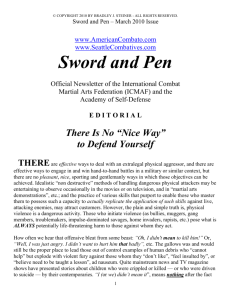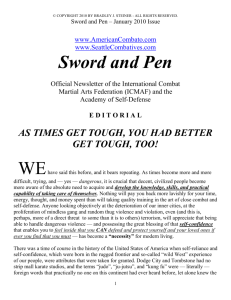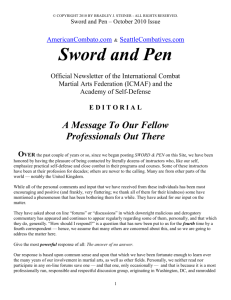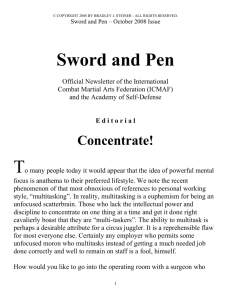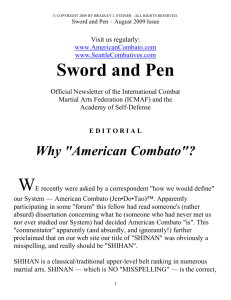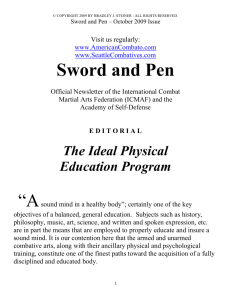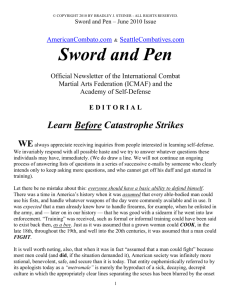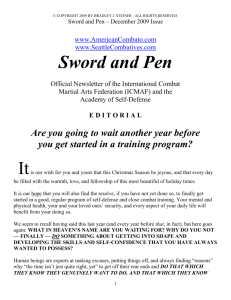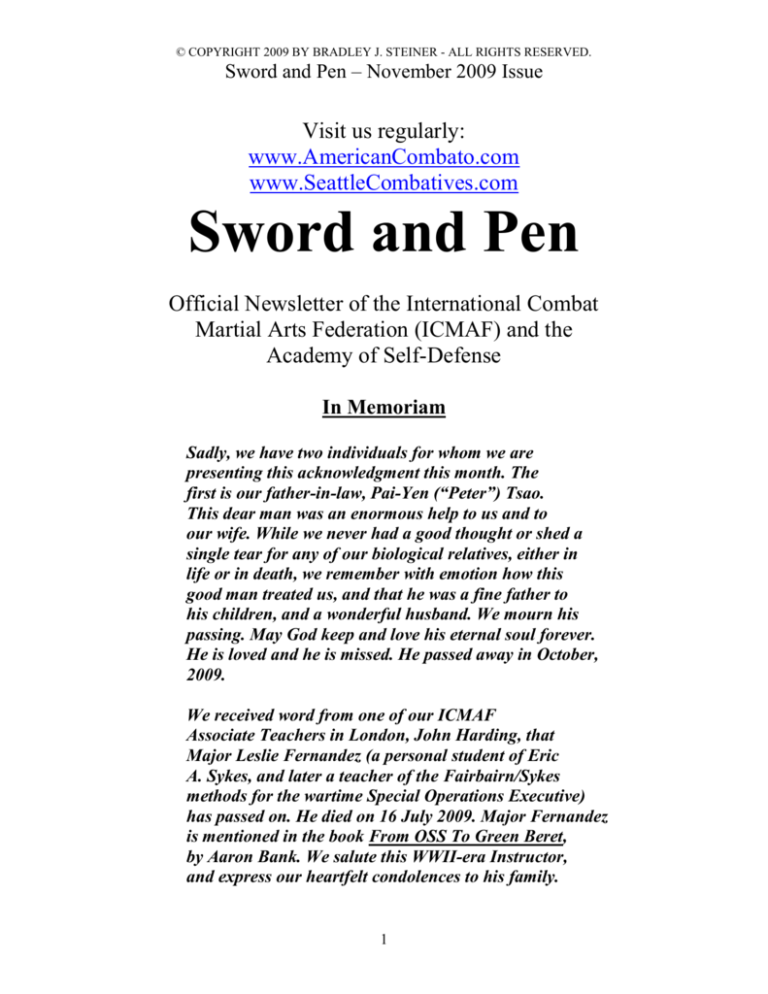
© COPYRIGHT 2009 BY BRADLEY J. STEINER - ALL RIGHTS RESERVED.
Sword and Pen – November 2009 Issue
Visit us regularly:
www.AmericanCombato.com
www.SeattleCombatives.com
Sword and Pen
Official Newsletter of the International Combat
Martial Arts Federation (ICMAF) and the
Academy of Self-Defense
In Memoriam
Sadly, we have two individuals for whom we are
presenting this acknowledgment this month. The
first is our father-in-law, Pai-Yen (“Peter”) Tsao.
This dear man was an enormous help to us and to
our wife. While we never had a good thought or shed a
single tear for any of our biological relatives, either in
life or in death, we remember with emotion how this
good man treated us, and that he was a fine father to
his children, and a wonderful husband. We mourn his
passing. May God keep and love his eternal soul forever.
He is loved and he is missed. He passed away in October,
2009.
We received word from one of our ICMAF
Associate Teachers in London, John Harding, that
Major Leslie Fernandez (a personal student of Eric
A. Sykes, and later a teacher of the Fairbairn/Sykes
methods for the wartime Special Operations Executive)
has passed on. He died on 16 July 2009. Major Fernandez
is mentioned in the book From OSS To Green Beret,
by Aaron Bank. We salute this WWII-era Instructor,
and express our heartfelt condolences to his family.
1
© COPYRIGHT 2009 BY BRADLEY J. STEINER - ALL RIGHTS RESERVED.
Sword and Pen – November 2009 Issue
EDITORIAL
Genetics And Individual
Development
U
nfortunately, an acceptance of reality is not one of the more conspicuous characteristics
of the thinking style of most of those who participate in the martial arts. ―Mystique‖ is what one
of our teachers, Charlie Nelson, used to call it. We think that he was being polite, however.
Irrational, unrealistic, absurd, and self-defeating foolishness appears to us to be more
appropriate. Something as innocent as a ―mystique‖ can actually prove merely to be a charming
―added attraction‖. Thus, if you find that the pursuit of whichever martial path you enjoy to be
enhanced by some mystique, that’s okay. But if you allow yourself to abandon truth, facts, and
reality because that which you participate in is essentially teaching you nonsense, and the
―teacher‖ of that system simply does not know the reality of that which he purports to be
disseminating as doctrine, you’re potentially doing great harm to yourself.
We have been intimately and professionally involved in the physical training and martial arts
fields since the early 1960’s, and the mid-1950’s, respectively. In both fields we have noticed
that participants and so-called ―teachers‖ alike have tended to ignore an extremely important
factor when pursuing their activities: GENETICS. That is, those hereditary factors that
predispose the individual to agility, hand/eye coordination, strength, athleticism, favorable or
unfavorable bone and muscular structural development, etc. Insofar as the physical training
aspect is concerned, suffice it now to say that, while everyone can build strength and muscle
and become much more efficient and effective physically if he follows a progressive, systematic
plan of weight training exercise, only those with the right genetics can become ―world class‖
physical specimens, or outstanding strength athletes. That‟s the way it is.
But let’s talk about the primary subject of this Newsletter: The armed and unarmed combat arts,
close-in hand-to-hand fighting, and self-defense. And let’s make totally clear that which many
simply do not understand, or have been misled about: i.e the critical role of genetics in
determining that which can and cannot likely be achieved by the student through training, and
the inevitable effect that one’s genetic predispositions have in determining one’s ultimate
development as a physical combatant.
2
© COPYRIGHT 2009 BY BRADLEY J. STEINER - ALL RIGHTS RESERVED.
Sword and Pen – November 2009 Issue
First, some encouraging facts:
1. Anyone, except perhaps the severely handicapped and/or those who are unfortunately
physically crippled or sick, can develop a serious, formidable capability in close combat and
self-defense. The only requirement is strong desire, hard work, patience, and determination,
coupled with sound instruction and reliable, professional guidance.
2. One does not need great natural strength, unusual agility, particularly superior hand/eye
coordination, or much athletic talent to master practical, realistic, modern personal combat and
defensive skills. These skills are well within the capabilities of statistically quite average people
to master, and even excel in.
3. A ―genetically inferior‖ individual who has developed his capabilities and skills in close
combat can defeat a ―genetically superior‖ individual who has not similarly developed his
capabilities.
4. There are numerous tactics and strategies that are integral to the study of modern and
practical close combat and self-defense that can make ―genetic advantages‖ in adversaries
virtually irrelevant, providing these tactics and strategies are applied quickly enough, and with
cunning and skill.
5. Weapons — which are a natural part of close combat and self-defense training, when this
subject is properly taught — trump ―genetic superiority‖ when and if the genetically superior
party is unarmed. At the very least weapons EQUALIZE, and place anyone on an even keel
with anyone else who is similarly armed, when weapons are involved. I.e. If a frail 80 year old
man who knows how to use it is in possession of a .45 automatic, and if he is confronting a 20
year old home invader who is also armed with a .45 pistol, the age, strength, and size
differences
between the two matter not a bit. Each is equally capable of dropping the other; and all that
matters is ―who gets who first‖. (And, when an intended victim is, happily, armed with a
powerful handgun, and his would-be killer or tormentor is not, the odds are overwhelmingly
with the intended victim. — no matter how great the victimizer’s size, strength, age, etc.
advantage may be!)
6. Genetics is important; but when considering all factors involved and concerned, genetics is
NOT the decisive factor in close combat or in emergency defense situations.
3
© COPYRIGHT 2009 BY BRADLEY J. STEINER - ALL RIGHTS RESERVED.
Sword and Pen – November 2009 Issue
Now, let’s point out how and why, despite the above, this matter of genetics is so critical a
matter to understand for those who pursue martial arts for self-defense.
First, remember that, unless you possess the requisite natural flexibility and physiology you
can be seriously and permanently injured if you elect to train in any martial art that demands
constant and extreme training for maximum flexibility. There is real danger here, in other
words, for the individual who undertakes the study of certain martial arts in which maximum
stretching is demanded of students, and high kicks are invariably part of the program. Those
individuals with the inherent flexibility can easily train to do all sorts of high and acrobatic
kicks, and stretch to their heart’s (and to their instructor’s) content. But NO ONE who does not
possess this inherent capacity should do any extreme stretching. The ligaments and tendons can
be permanently damaged by this; the hips can be permanently injured, and severe muscle strains
and even tears can occur. When a student is very young (early to late teens, and even through to
his mid-20’s) he can often ―get away‖ with doing a great deal of extreme stretching, and not
suffer badly for it. But this becomes a dangerous practice once one he approaches the age of 30,
if he isn’t genetically predisposed to great natural flexibility.
Second, unless you have naturally large, strong hands,and — preferably — fairly thick and
heavy fingers, you are virtually wasting your time training in the popular ―wrist turning‖ and
wrist-twisting and control actions. Adversaries who are heavy-boned and naturally strong can
easily resist and pull away from any ―expert‖ whose hands and fingers are relatively diminutive
(i.e. small boned) and who attempts to apply the popular ju-jutsu type kote-gaeshi grips. (Note:
We do not recommend these techniques at all for anyone; however, they are simply useless for
the person with small, fragile hands. The only effective application that such an individual
could enjoy with such holds is when working with a cooperative partner or a non resisting
opponent — quite unlikely in a real situation!)
Third, ―hard‖ linear (ie Shotokan karate style) blocks require great power and strong arms
and hands or they are entirely worthless against stronger, determined assailants who come in
with powerful, fully committed attacks — with or without a weapon of some kind in their hand.
A physically diminutive person who attempts a hard block against a vicious, powerful attacker
who comes at him, will FAIL to stop the attack with his block.
Fourth, if your ―self-defense‖ program advocates clenched fist punching, then WATCH OUT!
For, unless you possess the strength and hand structure that at least allows for strong punches to
be delivered, your ―punches‖ stand NO CHANCE of even bothering, let alone stopping, a
large, strong attacker.
4
© COPYRIGHT 2009 BY BRADLEY J. STEINER - ALL RIGHTS RESERVED.
Sword and Pen – November 2009 Issue
Fifth, Raw strength — much more than ―finesse‖ and skill — is required to pull off many of the
popularly taught throwing actions of judo or (what is often mislabeled as, but nonetheless
taught as) ju-jutsu.
Sixth, FORGET COMPLETELY about being able to secure an immobilizing hold on any
dangerous and determined enemy in a serious hand-to-hand encounter (except perhaps a
strangle or choke hold) unless you are very agile and very strong.
Seventh, the truth is that numerous martial arts systems depend, due to the manner in which
they are constructed and taught, on the participant’s possessing very specific physiological
characteristics in order to reach a high level of PRACTICAL proficiency. In this regard note
how the very advanced individuals in some arts tend to possess very similarly structured
physiques and inherent characteristics.
What all of this means is simply that you must be realistic and pragmatic when approaching the
study of close combat and self-defense. Unless you possess the right genetics, many
classical/traditional skills are totally worthless. And, if you are smart and go to a combat/selfdefense system of merit (watch out, many are simply classical/traditional or
sporting/competitive methods that have been ―renamed‖ for commercial purposes!) then you
need to appreciate the role of genetics in your training. DO NOT BE LED TO BELIEVE THAT
YOU CAN, WITHOUT THE HEREDITARY POTENTIAL, EQUAL THE STRENGTH AND
SPEED OF MOVEMENT, OR THE AGILITY, DEMONSTRATED IN PRACTICE, THAT A
NATURALLY BLESSED PERSON WITH THE GENETIC ADVANTAGES IS CAPABLE OF
EVIDENCING.
JUST ABOUT ANYONE CAN BECOME EXPERT IN PRACTICAL, REALISTIC
SELF-DEFENSE AND CLOSE COMBAT METHODS; BUT, AS WITH ALL THINGS
PHYSICAL, NOT EVERYONE CAN BECOME AN EXCEPTIONAL, AND
OUTSTANDING TECHNICAL PERFORMER.
Do not let any of this bother you. Just be self-accepting and realistic, and approach this matter
of acquiring physical combative capabilities with the same common sense and realism that you
(hopefully) employ when approaching the study of any other subject.
Excise the ―mystery‖, the ―fantastic‖, the ―secret‖, and the impossible forever from your
thinking. No matter what you read, hear, or are told by anyone regarding martial arts and
self-defense.
Bradley J. Steiner
5
© COPYRIGHT 2009 BY BRADLEY J. STEINER - ALL RIGHTS RESERVED.
Sword and Pen – November 2009 Issue
Core Exercises Build Power
Weight training, properly done, is the finest single form of supplementary exercise that anyone
engaged in the study of close combat and self-defense can pursue.
For those visitors to this site who might want a recommended personal training program, we
wish to outline an excellent all round routine. It is built around the key or core exercises that
may be relied upon to build the maximum amount of total body power and overall muscular
development and condition.
The CORE EXERCISES are:
• The squat
• The dead lift
• The standing overhead press
• Rowing
• Bench pressing
• Curling
• Abdominal exercise
In fact there is an enormous number of weight training exercises. The numerous appliances and
machines that one may find in most well-equipped gyms permit an all but infinite number of
variations, when combined with the incredible number of simple barbell and dumbell
movements that may be done. Do not be confused or misled by all of this. The truth is that
only a relatively small number of key exercise movements are required for the best
development and strength gains, and good training schedules are simple, brief, and
require nothing elaborate in the way of equipment or facilities. A simple barbell set and a
pair of adjustable dumbells that you keep in your apartment will be more than enough to
enable you to acquire terrific development.
6
© COPYRIGHT 2009 BY BRADLEY J. STEINER - ALL RIGHTS RESERVED.
Sword and Pen – November 2009 Issue
The secret to arranging good, productive training routines is to always utilize some variation of
the CORE, BASIC EXERCISE MOVEMENTS, and avoid deviating into the lesser, ―smaller‖
exercises that, in reality, do little for solid results of a meaningful kind.
Good principles of training must also be employed. These include:
• Training the entire body at each workout session
• Keeping a workout within reasonable time constraints
• Using a sufficient number of exercises, without overburdening a routine with too many
different movements, to work the entire body thoroughly and well, and cultivate all of the
desirable physical attributes
• Limiting the number of sets, and utilizing realistic repetition schedules
• Striving incessantly — during the ―building up‖ years — to handle more and more weight
WHILE AVOIDING POOR EXERCISE FORM (I.E. “CHEATING”) OR ATTEMPTING
TRULY EXCESSIVE POUNDAGES TOO SOON
• Training at a brisk but not hurried pace, striving to go from one exercise or set into the next as
soon as you have recovered from the previous exertion
• Being cognizant of the onset of ―staleness‖ and/or possible overtraining, and resting when
necessary between routines
• Changing routines periodically — but only by utilizing variations of the core exercises; never
by training on ―fad‖ routines, or on exercises that produce predominantly cosmetic results
without increasing strength significantly, or assisting in the development of good, overall
condition, agility, and fitness.
Please get this important point: THERE ARE NO SPECIAL “MARTIAL ARTS” WEIGHT
TRAINING OR EXERCISE PROGRAMS. A well-planned all round program of progressive
resistance exercise is what you want and need. Any specific close combat and defense training
(i.e. using breakfalls, hardening the natural weapons, etc.) may be undertaken if you wish — but
the general and overall development of your strength, condition, fitness, agility, well-being, and
health will be fully and completely taken care of by following a proper program of weighttraining. And that program is the same for anyone, whether a combat arts trainee, a ping pong
player, a swimmer, or a bank teller.
7
© COPYRIGHT 2009 BY BRADLEY J. STEINER - ALL RIGHTS RESERVED.
Sword and Pen – November 2009 Issue
Another thing. Physical training will not compensate for lack of practice of the skills that you
wish to acquire and to maintain functional proficiency in. Proper exercise will bolster your
general physical capacities and capabilities, but it will not and cannot produce ―skill‖. So,
recognize this, please. Use your weight training program in addition to your regular, systematic
practice of techniques. Merely ―building up your body‖ will not per se develop technical
combative armed and unarmed combat ability.
The late Bob Hoffman once wrote that ―A stronger athlete is a better athlete,‖ and that is
absolutely true — all other things being equal. However, it is not true that ―a strong man is an
athlete, per se‖. You will need to train hard and to practice your combat skills AS WELL AS
workout regularly with weights.
The following is a simple, excellent all round workout routine that will five anyone who follows
it properly good results.
1. Warmup with some light total body movement — using weights or calisthenics
2. Squat — 2 sets of 15 repetitions (First set, light; second set, medium-heavy)
3. Deep-breathing two-arm pullovers using empty bar, and doing one set of 12 repetitions after
each of the two sets of squats
4. Standing military press — 1 set of 10 reps (comfortably heavy); 1 set of 5-6 reps (heavy)
5. Two-hands barbell curl — 2 sets of 8 reps (moderate)
6. Bench press — 1 set of 12 reps (medium resistance); 1 set of 6-8 reps (heavy)
7. Bent-over barbell rowing — 1 set of 12 reps (medium resistance), 1 set of 8-10 reps (heavy)
8. Dead lift — 1 set of 8 (light warmup), 1 set of 6 (medium-heavy), and set of 6 (heavy)
9. Leg raises or situps — 2 sets of 25-40 (moderate weight — either ―iron shoes‖ or barbell
plate, for situps)
After five to eight months going to a maximum of three sets, adjusting repetitions and weights
according to experience, is a good idea.
8
© COPYRIGHT 2009 BY BRADLEY J. STEINER - ALL RIGHTS RESERVED.
Sword and Pen – November 2009 Issue
We have deliberately avoided recommending such exercises as lat machine pulldowns, dips
between parallel bars, and chinning, since we wish to provide a program that is easy for
virtually anyone with only the simplest home training equipment to follow. However, if you
have access to a well-equipped gymnasium, then utilizing variations of the basic, core exercises
requiring somewhat more advanced equipment than a barbell and dumbells is an excellent idea.
But do not concern yourself if you never have access to anything more than a barbell, dumbells,
and set of squat racks and a bench! You can build yourself to the limits of your genetic potential
with that simple equipment. The other equipment is good, but merely for variety.
Defense Against Abduction
―Get in the car or I’ll blow your head off!‖
―Come with me and I won’t hurt you; but I’ll use this knife if you resist!‖
―Just come with us, and we won’t hurt you. But if you so as much as move the wrong way,
we’ll kill you!‖
―You can’t get away, so just come with me and don’t make a sound!‖
It is difficult to imagine hearing more terrifying words than those above, spoken by one or more
violent offenders whose clear intention is to effect your kidnapping. Only a genuine idiot would
regard such a situation as being either non-frightening, or ―easy to handle if you’re trained in
the martial arts‖.
In fact, it is to prepare decent people to deal PRECISELY WITH THIS KIND OF HORRIFIC
THREAT, and not to ―win contests‖, or to ―be a champion‖, that genuine combat training and
quality self-defense instruction ought to be — and in the case of American Combato and similar
systems — IS intended and directed.
But many would ask: “What could one possibly do in such an awful situation? Would it not
prove futile — even suicidal — to attempt any resistance when confronted by this kind of
threat?”
Without in the least denying the lethal nature of such an admittedly awful predicament, we must
emphasize that by no means is resistance either ―futile‖ or ―impossible‖. In fact, we will not be
surprised if we learn that many black belts would disagree with us, and that SUBMISSION and
COMPLIANCE would be their (well-intended, but completely incorrect) advice, in the face of
this kind of situation.
9
© COPYRIGHT 2009 BY BRADLEY J. STEINER - ALL RIGHTS RESERVED.
Sword and Pen – November 2009 Issue
The truth is that the best (i.e. most likely to save the intended victim) reaction to an abduction
attempt is the SURPRISE EMPLOYMENT OF WELL-EXECUTED DEADLY FORCE
SKILLS BY THE INTENDED VICTIM. And, there’s a ―right way‖ to do it — the rudiments
of which we shall now explain.
Here, in a nutshell, is what you need to know about defending against abduction:
1. THE SITUATION IS NOT “HOPELESS.
2. YOU NEED TO KEEP YOUR COOL
3. YOU NEED TO CONVEY A MISLEADING ATTITUDE
4. YOU NEED TO ABSOLUTELY KNOW AND FEEL THAT YOUR LIFE IS AT STAKE
5. YOU NEED LETHAL SKILLS AND — ABOVE ALL — THE UNHESITANT
WILLINGNESS TO USE THEM WITHOUT RESTRAINT OR MERCY
6. YOU MUST NEVER PERMIT YOURSELF TO BE REMOVED FROM THE INITIAL
SCENE OF CONFRONTATION WITH THE ABDUCTOR(S), AND YOU MUST
NEVER ALLOW YOURSELF TO BE PLACED IN A PHYSICALLY HELPLESS
POSITION
7. YOU MUST ACT AS SOON AS REALISTICALLY FEASIBLE ACCORDING TO YOUR
ASSESSMENT OF THE SITUATION, AND IN LIGHT OF THE ABOVE
8. THE VERY SECOND YOU HAVE CREATED THE OPPORTUNITY TO DO SO,
YOU MUST ESCAPE THE SCENE AND GET AS FAR AWAY AS YOU CAN, AS SOON
AS POSSIBLE.
Killing a would-be criminal kidnapper is not merely ―legal‖ — it is the proper thing to attempt
to do, if you are able to do it, because it provides you with certain safety if successful, and,
whether completely successful or not, it provides you with the surest means of getting away.
Too many softies resist this ―politically incorrect‖ idea today. The idea that, somehow, there is a
―nice‖ or a ―sanitized‖ way to defend against a lethal threat is a popular (and very stupid)
misconception.
Face it: If you are confronting the threat of kidnap, then your LIFE is at stake.
10
© COPYRIGHT 2009 BY BRADLEY J. STEINER - ALL RIGHTS RESERVED.
Sword and Pen – November 2009 Issue
Since kidnappers will not likely attempt their act when there is plenty of help around, and/or
when you have a pretty decent avenue of escape open to you by running, you will be on your
own. Remember, in this awful situation, that abductors do NOT wish to kill you at the moment
of the abduction. For whatever reason they want to take you elsewhere, and to do so speedily,
quietly, and without risk to themselves. Your opportunity for escape and survival is never going
to be greater than it is AT THE SCENE OF THE ABDUCTION ATTEMPT — AND AS
SOON AS POSSIBLE.
Later on, after your kidnapper(s) has taken you away, your chances of surviving and escaping
drop drastically, as you will be in a more secured environment (from the kidnapper’s
perspective), you will be further away from any help, you will almost certainly be more
mentally terrified and confused, and you’ll probably have undergone some physical ―softening
up‖ (ie being BEATEN) by your abductor(s). You may, as captivity is prolonged, be deprived
of adequate clothing, footwear, and nourishment. You may even be drugged. The message is:
YOU MUST GET AWAY AS SOON AS POSSIBLE.
You cannot allow yourself to be tied up, handcuffed, shoved into a vehicle’s trunk, taken on
board a vessel or aircraft, or otherwise placed in a position of total helplessness.
Should your kidnapper intend any of the above, PRETEND momentarily to be terrified and
compliant, then ATTACK HIM WITH LETHAL INTENT AND DO NOT STOP
ATTACKING UNTIL YOU HAVE ELIMINATED THE THREAT AND ARE ABLE TO
ESCAPE.
If held at knife or gunpoint you must initially surrender. Convey fear and compliance. BUT
THE VERY MOMENT YOU PERCEIVE THAT YOUR ABDUCTOR BELIEVES YOU ARE
UNDER HIS CONTROL, KNOCK THE WEAPON ASIDE AND — IF YOU CAN — KILL
HIM IMMEDIATELY.
Even if confronted by apparently unarmed abductors, whenever there is more than one, feign
initial fear and compliance. This will normally prevent them from initiating what might be a
knockout blow or overwhelming physical attack that you will be unable to repel immediately.
WAIT. Let them believe that they’ve got you. Then ATTACK! Then get away.
In the unlikely event that you are confronted by a solitary and apparently unarmed abductor,
make no initial telegraphing move, but without warning kick him in the testicles, chop him
across the neck or throat, ram your fingers into his eyes and then break his leg with a side kick,
etc. Then GET AWAY.
11
© COPYRIGHT 2009 BY BRADLEY J. STEINER - ALL RIGHTS RESERVED.
Sword and Pen – November 2009 Issue
Remember that anyone — kidnapper or other lethal felon — who points a weapon at you
and whose intention it is to cause you to comply with him, thereby, HAS PLACED
HIMSELF ON THE DEFENSIVE. That means that the intended victim has the
opportunity to select the moment when he will act, and the intended victim GETS TO
MAKE THE FIRST MOVE!
Remember that it is not merely your life that an abductor is directly menacing, it is the life of
every individual whom you love and who loves you. Remember that anyone dependent upon
you will lose you if the abductor is successful. Remember, above all, that you must forthrightly,
fully, and without the slightest tremor of hesitancy, PLAN ON KILLING AND INTEND TO
KILL as effective preparatory training any individual or individuals who would forcibly kidnap
you, or your reaction will be pathetically weak and ineffective, in a predicament that is already
lethally serious and grave. This does not mean that in order to survive and escape you will
inevitably have to kill your abductor. It means that initiating anything less than lethal force in
your escape effort is foolish. Whether or not a kidnapper dies is irrelevant. By his action he has
forfeited any right that he may have had to even the slightest mercy or consideration. SO DO
NOT GIVE HIM ANY!
Thus far it has been our assumption that you will not be armed at the time of the kidnap attempt.
Obviously, if you are armed, your weapon must be used as expertly and as unhesitantly as you
are capable of using it. Remember that you may not be able to access a pistol or a knife quickly
enough in an emergency, and you may well need to respond with unarmed force in order to gain
the time and the distance needed to secure your weapon. DO NOT TRY TO “ARREST” YOUR
ABDUCTOR(S). This will place you on the defensive, and you do not want to be thusly
positioned. Just use that weapon to full effect, and do not hesitate or restrain yourself in the
least. YOUR LIFE IS HANGING IN THE BALANCE!
There may be an object at hand with which you are able to assist yourself. If so, USE IT! Use it
quickly, brutally, repeatedly, and without mercy, until you can safely escape.
The prospect for survival when or if kidnapped is frighteningly poor. On the other hand, the
odds of successfully escaping BEFORE THE ABDUCTION HAS BEEN SUCCESSFULLY
ACCOMPLISHED are considerable. In any case, it is always worth taking the chance, and
taking action.
SPECIAL NOTE: We have, during the last several years, had the privilege of training a
number of our Nation’s fighting men prior to their departure for the cesspool of the Middle
East. We have invariably counseled these young men to NEVER FAIL to be armed with a
12
© COPYRIGHT 2009 BY BRADLEY J. STEINER - ALL RIGHTS RESERVED.
Sword and Pen – November 2009 Issue
readily accessible, razor-sharp fighting knife AND with a loaded, powerful handgun.
Unfortunately we have had to say “To hell with the regulations!” when one or another of
these men has advised us that such would not be permitted. the fact is, resisting an abduction
attempt and dying while killing one’s abductors (a worse case scenario) beats ending up on
the internet and being publicly beheaded by savages.
Our advice to those wonderful men who serve in the defense of our Country is the same.
Whenever it is a matter of “survival versus compliance with rules” choose SURVIVAL!
Fairbairn’s Two Key Principles
Of the various WWII systems and methods of close combat we believe that the best was the
Fairbairn System. This method, taught in a Course that was titled “Silent Killing”, was given to
secret agents of both the British Special Operations Executive and the American Office of
Strategic Services, as well as to American FBI agents, and to British Commandos. The Course
was a bare bones presentation of kill or be killed skills and tactics intended to ready any novice
for handling the most savage situations of hand-to-hand combat — and WIN.
While we certainly appreciate the enormous merits of O’Neill’s program, and of the excellent
three-tiered Naval Aviators’ course prepared and administered by Brown and Begala, we do
believe — after learning and seriously studying and practicing ALL of these systems, as well
as others, that Fairbairn’s was the best of the lot. Of all the wartime methods (and we
incorporate the cream of every single one of them into American Combato’s curriculum) it was
the Fairbairn System that influenced us the most.
Fairbairn’s personal close combat experience was, hands down, light years beyond that of
anyone else, in the 1940’s. In fact, IT STILL IS SUPERIOR TO THE PERSONAL
EXPERIENCE RECORD OF ANY OTHER KNOWN TEACHER OF HAND-TO-HAND
COMBAT AND SELF-DEFENSE IN THE WORLD, and well may remain so, permanently.
It is doubtful that anyone will surpass the 600-PLUS personal involvements in actual combat
that were a part of Fairbairn’s personal record, when he and his colleague, Eric Sykes, were
brought into government service from retirement from the Shanghai Municipal Police
Department, during the early years of WWII.
Fairbairn’s deep understanding of personal combat prompted him to drastically alter his
“Defendu” (which, deservedly, flourished during the Shanghai years as a superb method of
police tactics for arrest and control, and for self-defense), and to create a KILLING METHOD,
suitable to the requirements of war. One need only juxtapose SCIENTIFIC SELF-DEFENCE
(Fairbairn’s tome, written when he was Assistant Police Commissioner and Officer in Charge of
Musketry at eh SMP) with ALL-IN FIGHTING/GET TOUGH! (Fairbairn’s WWII text, used
13
© COPYRIGHT 2009 BY BRADLEY J. STEINER - ALL RIGHTS RESERVED.
Sword and Pen – November 2009 Issue
extensively by the Allies to meet the challenge of brutal, deadly battlefield combat) to see in
what manner this is true.
It was in the Silent Killing Course that Fairbairn made specific mention of his two primary rules
for winning in hand-to-hand combat. He emphasized to all who taught his Course that these two
principles were to be emphasized in the extreme, just as soon as students had completed but
the second section of the Course, itself. These two principles are:
1. ATTACK FIRST, and
2. KEEP ON ATTACKING
whenever you must engage an enemy in hand-to-hand combat.
Nothing has changed either in the nature of man or in the nature of close combat that makes
either of those two principles any less valid, critical, and important today than they were in
1942, when first put down on paper by the Maestro himself, ―Dangerous Dan‖ Fairbairn!
At first blush those principles would appear to have relevance to the wartime fighting man, but
not to the student of self-defense. WRONG! And this is why:
Whenever you are in a situation where another presumes to initiate violence against you, you
will either see it coming, or it will take you by surprise. There are no other possibilities.
In a proper program of preparation for self-defense you learn that THE VERY MOMENT IT
BECOMES CLEAR TO YOU THAT ANOTHER IS INITIATING AN ATTACK AGAINST
YOU, YOU MUST ATTACK, YOURSELF! THIS IS PRE-EMPTING, AND IT REMAINS
THE SINGLE FINEST STRATEGY FOR ANYONE TO EMPLOY IN UNAVOIDABLE
SELF-DEFENSE SITUATIONS.
But what about those situations in which you may be taken off guard — by surprise? What
then? Very simple: YOU TURN THE TABLES AND BECOME THE ATTACKER AS SOON
AS POSSIBLE, AND YOU THEN PRESS AN ATTACK OF YOUR OWN TO THE LIMIT,
UNTIL YOU ARE NO LONGER IN DANGER.
WHEN YOU ARE ATTACKED, ATTACK THE ATTACKER!
We put it thusly to our students: “So long as you are „defending‟ you are LOSING. As soon as
you begin „attacking‟ you are WINNING.”
14
© COPYRIGHT 2009 BY BRADLEY J. STEINER - ALL RIGHTS RESERVED.
Sword and Pen – November 2009 Issue
There is no purely defensive method of self-defense that is at all reliable. We appreciate that
this will bring howls of protest from avid students of aikido and related methods, and we are
sure that the “karate begins and ends with blocking” crowd will hate what we are saying. But
what we are saying is TRUE, nevertheless. Try to protect yourself by not harming your
assailant, or merely by stopping his aggressive action, and nothing more; or perhaps wait until
two or three punks who are making it clear that they intend to attack you actually commence a
full blown onslaught before you go into decisive action, and you have committed inadvertent
suicide. That’s the way it is in REAL COMBAT.
The ―dojo‖ is not the real world. If you wish to be prepared for actual, honest-to-goodness
human violence and savagery then you need to revise any thinking about transposing that which
you’d LIKE to believe is true, from the training hall to the street, and start analyzing that which
occurs in the street, and letting it influence that which you train for, when you’re in the training
hall!
Fairbairn was on the money when he stressed attacking and continuous attacking as the formula
for victory in close combat. Disregard those two principles at your peril.
To attack first in no sense implies that you should start fights. What it means is: When someone
starts to attack you, attack him, and neutralize the threat while it is still in its embryonic stage.
Remember that it is completely legal to defend against the ASSAULT stage of any attack. You
do not need to wait until actual BATTERY takes place — for by that time it may well be too
late for you to do anything.
To keep on attacking does not mean to continue to pummel a helplessly downed and out of
commission opponent who is no longer a threat. It means to CONTINUE ATTACKING A
DANGEROUS ASSAILANT UNTIL IT IS CLEAR TO YOU THAT HE CAN LONGER BE
A THREAT. Completely rational, sane, and legal.
It has always been, and it will always be, our objective in American Combato to instruct decent
human beings in lawful, effective self-defense measures. We will not tolerate violent people as
students, nor will we tolerate the development of any tendency to ―prefer‖ violence over
peaceful behavior, should such an attitude appear to be developing in a student. (We have never
seen this last phenomenon; but we are ever-mindful of the possibility of its occurrence). This
objective does not and cannot encourage an abandonment of the tactical imperatives that make
for success in violent emergencies. Once it is clear that the avoidance of an assailant is
impossible, then it is time to ―get tough‖, as the title of Fairbairn’s Classic so eloquently tells
us. There’s no nice way to handle a violent attacker. He must be stopped. And the act of
15
© COPYRIGHT 2009 BY BRADLEY J. STEINER - ALL RIGHTS RESERVED.
Sword and Pen – November 2009 Issue
stopping him entails injuring him — and doing so with sufficient followup to insure that he will
not be able to pose any further danger, once we, as the defender, desist in our own counter
action.
In summary then, whether you are a soldier, marine, police officer, or private citizen; whether
the context in which you anticipate the possibility of hand-to-hand violence coming your way is
on a battlefield or in the street, you must be prepared for what real combat demands. And a
giant step toward achieving that preparation is to absorb and to cultivate the ability to utilize
Fairbairn‟s two key principles: 1. Attack, and 2. Keep on attacking.
These principles worked for the Allies on the battlefields of world war two. They will work for
YOU today, on the mean streets of urban America.
Why The All-Out 100% “Drive To The Wall”
Is Necessary
We have sometimes been questioned regarding our philosophy of always attacking 100% and
going ―all out‖ in the face of a sudden, violent attack. ―Why,‖ some people have wanted to
know, ―do we not at first attempt to stop an attacker with a low level of force, and escalate to
something more severe only if and when absolutely necessary, and only because the attack
proves to be potentially deadly?‖
Our answer is, “For the same reason that it is recognized as sheer idiocy to fire „warning shots‟
with a firearm, when one is attacked in a manner that justifies the use of a sidearm — and/or —
for the same reason that one does not try to „shoot a gunman‟s weapon out of his hand‟, instead
of shooting into that gunman‟s kill-zone, when under lethal attack”: UNDERTAKING SUCH
ACTION WHEN ONE IS UNDER ATTACK IS SIMPLY TOO DANGEROUS TO RISK
TRYING, AND, JUST AS PERTAINS TO THE NOTION OF “SHOOTING A GUN OUT
OF AN ARMED MAN’S HAND”, IT IS ALL BUT IMPOSSIBLE TO ATTEMPT
ACROBATIC NONSENSE SUCH AS THE APPLICATION OF “ARRESTING
CONTROL” IN THE FACE OF A REAL ATTACK.
People who have not studied, researched, or been involved in real violence often have ideas
regarding how violence may be handled put into their heads via motion picture and television
shows. They then wonder why — in the real world — such methods as they see successfully
rendered on the silver screen are not undertaken in actual confrontations. But in the real world
violence is not a choreographed performance as it is on TV and in the movies. In the real
16
© COPYRIGHT 2009 BY BRADLEY J. STEINER - ALL RIGHTS RESERVED.
Sword and Pen – November 2009 Issue
world the good guy does not always win. Therefore, when good guys seek training in personal
combat methods for self-protection they have a LOT to learn — not merely ―technically‖, but
tactically, mentally, and even emotionally, too.
When one is projected into a violent situation one has no possible way of knowing the
intentions or the capabilities of one’s attacker(s). One must assume that one’s life is in peril, and
one must do everything one possibly can RIGHT AWAY, WITHOUT ALLOWING THE
SITUATION TO BECOME ANY MORE GRAVE THAN IT ALREADY HAS BECOME. The
alternative to this is to attempt ―lesser means‖, so as not to injure one’s attacker ―too much‖.
But consider this: An attacker has chosen his course of action willfully. He knows what he
wants to do, and he is demonstrating without question or doubt that he is willing to injure his
intended victim. Only HE knows his ultimate objective. For all his intended victim can guess, it
is the attacker’s purpose to murder him — and perhaps to murder the immediate victim;s loved
ones, as well. How could anyone logically impose a responsibility to concern himself with
ANYTHING save the immediate neutralization of the perceived threat?
And that is why we urge and advocate that which we do urge and advocate. We know that the
victim of an attack has but one responsibility: To defend himself and his loved ones. He, the
victim, did not ask for this predicament; the attacker has brought it on. The attacker is wholly
responsible for whatever his victim does to him. There is not the slightest reason why the
victim of any attack should care at all or concern himself in the least with the welfare of anyone
who endangers his life ny violently attacking him.
This is ―where we’re coming from‖.
No one in the world despises violence more than we do. We abhor physical aggression and
regard as mindless savages those who choose violence in any instance, save that of DEFENSE.
However, when defense is necessary — when it is MADE NECESSARY by some extralegal
misfit — then we advocate the victim;s instant and decisive counterattacking action; with NO
regard for the opponent. It is simply too dangerous for anyone to bother with anything but the
immediate application of decisive force when he is subjected to a violent attack. And in training
and preparation for this contingency, we instruct anyone whose life is in imminent danger to
attack ferociously and immediately, and to do so with utter disregard for the violent offender
who has made this action necessary.
A victim who follows our teachings may still be injured or killed. That merely underscores the
dire risk and danger of a physical attack. However, IF successfully defending himself is
feasible, then a 100% drive to the wall — relentlessly attacking with ferocity and
17
© COPYRIGHT 2009 BY BRADLEY J. STEINER - ALL RIGHTS RESERVED.
Sword and Pen – November 2009 Issue
determination until the threat is neutralized — will certainly turn the trick for the intended
victim.
Over the decades we have trained physicians, university professors, law enforcement officers,
school teachers, businessmen, housewives, engineers, soldiers, private investigators,
accountants, and virtually every type and variety of decent, respectable, peaceful human being
in every vocation, occupation, and calling. Such fundamentally good people need to understand
— to be taught to apply — attitudes, skills, and tactics that, were these people able to choose,
would never have become necessary. And that’s the point. One IS NEVER “ABLE TO
CHOOSE” TO AVOID A DETERMINED PHYSICAL ASSAILANT. ONE MUST DEAL
WITH HIM. And the manner in which dealing with such a creature is best accomplished —
proven in actual situations in both peacetime and during war — is by GOING AFTER HIM!
The 100% committed ―drive to the wall‖, all-out, the very second one realizes that one is in
imminent danger, is the way to go. It WORKS.
If you’re ever in trouble, use it.
Modeling Clay For Hand Conditioning
Traditional hand conditioning of the classical Chinese and Japanese striking (ie karate) arts can
be extremely hazardous. Many individuals have quite literally crippled themselves by overenthusiastic pounding on striking posts that have been padded with sheaved straw. Certain
Chinese methods actually involve cooking the hands in various herbal compounds — after
which the hands are certainly effective weapons, but are good for little else.
We believe very adamantly that every serious student of self-defense ought to train and
condition his natural weapons by striking into inanimate targets. The traditional striking post is
ideal, but not when padded with sheaved straw. Instead, hard rubber pads should be utilized, as
these do not damage skin and bone the way the old, traditional makiwara did.
Most of the crippling hand injuries that overly exuberant martial artists sustain are due to
training of the conventional clenched fist. The fist is not naturally suited to be a ―weapon‖ per
se, and when the bones of the hand are broken and pounded, and allowed to calcify so that the
knuckles become enlarged and impervious to pain, serious arthritis is almost a certainty. The
late karate Master Masutatsu Oyama spent the last years of his life horribly debilitated by the
abnormal hand conditioning procedures he had followed in his younger days. Oyama could
literally beat the knuckles of his hand with a hammer! Unfortunately, as he aged his hands
became completely crippled, and he could barely use them.
18
© COPYRIGHT 2009 BY BRADLEY J. STEINER - ALL RIGHTS RESERVED.
Sword and Pen – November 2009 Issue
The student of unarmed combat has no need for heavily developed knuckles for clenched fist
punching (although he should train his bare fists moderately to impart and to sustain hard
impact). The properly trained combat student punches only to soft area targets — like the
sternum, solar plexus, liver, testicles, spleen, and kidney — NEVER to hard, resilient parts of
the opponent’s anatomy (like the bony facial area, or the head). Moderate conditioning by barefist training on a rubber padded maiwara and/or on heavy bags, training dummies, etc. will
suffice. DO NOT TRAIN THE FISTS TO AN EXTREME FOR CLENCHED FIST
KNUCKLE PUNCHING! You do not need this kind of conditioning, and if carried to the
extreme of the classical/traditional ―karate master‖ where the bones calcify and become numb
to contact, you very well may cripple yourself.
We have found a very useful and effective aid to training the various bare hand weapons safely
and well: modeling clay. Modeling clay does not cut the skin, does not offer an unyielding
surface, and will not harm the hands when it is struck.
Purchase whatever amount of modeling clay you wish from any good art supply store. It may be
placed on any sturdily built work bench or table, on the floor, or on a large concrete slab or
cinder block. Practice pounding the clay with the handaxe chop, jabbing it with the heel of the
hand, poking and clawing it with your fingers, and pounding it with hammerfist blows. It is
particularly good for working the tiger’s claw thrust, and by kneading and clawing into the clay
you will strengthen your hand, fingers, and grip without risking injury.
Training with modeling clay will not produce the ridiculous calluses that a considerable number
of, shall we say, somewhat immature “karate-ka” covet. But it will give you a pair of hands
that, when employed in the various unarmed combat blows against a living human, will be
absolutely devastating.
Training for about 10-20 minutes a day is more than enough. Remember: All this training will
do is harden and prepare the natural weapons so that when they are delivered properly, they will
cause maximum injury. But the major portion of your training should always be devoted to
mastering the skills of proper delivery.
19
© COPYRIGHT 2009 BY BRADLEY J. STEINER - ALL RIGHTS RESERVED.
Sword and Pen – November 2009 Issue
Visit SEATTLECOMBATIVES.COM!
We post new material on our other site each month. Please enjoy the new offerings, and please
let others know that this material is being presented — free, and for any serious student and
teacher’s benefit.
We’ll close this edition of SWORD AND PEN by extending our best wishes to you and yours
for a very Happy Thanksgiving.
Until next month, stay combat ready!
Prof. Bradley J. Steiner
—END—
20

